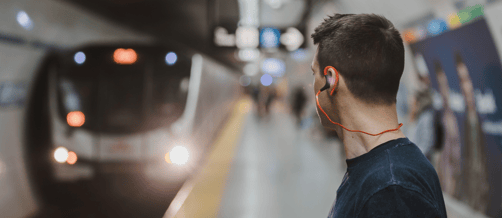
WiFi in Rail - What's the Value? | WiFi SPARK
When working through budgets or writing business cases for Transportation, services like WiFi may not be a priority on the to do list. Questions like “Is there...
Read more

Transport data collections have been carried out by the transportation sector to measure everything from traffic buildups and road surfaces to the condition of bridges and airfields.
There are various possible metrics that can be measured including the number of returning passengers, the number of new passengers, the most popular route on a Monday and the quietest day per station, to name a few.
Similar to this, data collected through WiFi and engagement platforms can help you to improve train station facilities and the overall passenger experience. Transport data collection is still possible with GDPR compliant software and can be utilised in a number of different ways.

Using passenger WiFi to collate valuable data is beneficial to Train Owning Groups (TOG) and Train Operating Companies (TOC) for a number of reasons. The information gives fantastic access to the passengers wants and needs, which you can use to improve their experience.
Intelligent data platforms keep you connected to your passengers like never before. The data generates unbeatable insights into passenger trends which you can use to improve facilities and sales.
You’ll be able to offer a customised and targeted experience, straight to the passenger’s device as well as learn more about who your passengers are, where they come from and how frequently they travel and on which routes. This data allows you to make smart decisions about your digital marketing strategies.
Northern Rail is looking to improve its services by monitoring passenger heart rate and wellbeing. Passengers that sign up to the project will receive a free wearable activity tracker as a thank you.
You can offer a similar kind of reward to loyal passengers with the WiFi. From repeated journeys, the WiFi will provide you with vital data that can improve passenger’s overall experience, whilst they receive access to a branded, informative, fast and reliable WiFi service.
Once the passenger has opted in, WiFi SPARK’s Analytics offers comprehensive insight into the demographics of your travellers.
The more information the passenger gives, the richer your data. This information could be age, gender, home postcode - anything you wish. They can choose to opt in to give this information or not, in line with GDPR policy.
TOC’s may already have passenger information through their own loyalty databases. Innovative WiFi providers can integrate with this and allow a passenger to authenticate to the WiFi with the same credentials.
Even if the passenger chooses not to sign up, the system collects anonymous data from users sessions. This information will show such data as peak travelling times, popular routes and the average amount of time that passengers spend waiting.
This information can be sent in real-time to your CRM to allow your BI teams instant access to this data. With enhanced services such as custom data feeds (Parking, weather etc) the Analytics platform can become a very powerful tool. Other enhancements could be location services where you can view the busiest areas of a station, or track movements over time giving insight to how passengers use and interact with the station and its shops or waiting areas.
Once you’ve started to collate information (anonymous or otherwise) from your passengers, you’ll be able to use it to make improvements. If you find there are lots of people spending long times in the retail zones but the sales are low, you could offer incentives or loyalty programmes to passengers to address this. If there are high dwell times across your station estate, this may open the door for conversations with retailers to come into your station environment with their stores.
By using engagement platforms and feedback incentives, you can ask passengers key questions about their experience and find areas of improvement that you can work on. They may offer suggestions on how their journey could have been better and what they’d like to see provided in the future.
Another example of utilising data to benefit the TOCs could be analysing the number of devices on given routes compared to other times of the year or other routes to measure the effectiveness of passenger travel. For example, key data collected through the WiFi can become hugely important when combined with Passenger Information data from other systems. Enhancing the ability to inform passengers that the train arriving five minutes later is actually quieter and potentially a service that would be more comfortable.
We provide solutions that are more than just WiFi for the transportation sector. Other providers may only give you internet access, but we offer a comprehensive platform that adds real benefit to both TOCs and passengers.
Passengers have access to a connected journey whereby they only need to sign into the system once when they arrive at the station or board the train. No matter where they’re going, or how many stops and changes they need to make, they’ll still be connected when they arrive at their destination, thanks to the mobile data offload functionality that WIFi SPARK has created.
Their connection is safe, secure and compliant, so you’re safe in the knowledge that all passenger information is protected from threats. If there are any issues, we provide exceptional support 24/7 to make sure everything is running smoothly.
With WiFi SPARK, you have access to all of the important analytics data, rather than having to go to another source. This data is yours and yours only and will never be used by anyone else. As well as the user and session data, the SPARK® Platform can integrate with other freely available data sources. You may have to provide a complete passenger profile and allow your staff to understand more about the station performance as a whole when it comes to passengers and their habits.
Another valuable resource is the User Experience (UX) which is the screen that passengers see when they connect to your network. This can be tailored to suit your specific needs and requirements and allow passengers to stream radio stations, order meals in first class, watch welcome videos and play games - all via one platform.
Passengers could use the platform to read important updates about their travel journey, including the latest train cancellations and platform changes. Maps can be integrated too, so that passengers can plan the next step of their journey, like a map of the London Underground. All of this is linked with the UX, right in the passenger's hand.
By collecting data, TOCs are able to take control and use the knowledge gained to provide a better, targeted service, to improve passenger satisfaction. For more information on WiFi SPARK’s work with the transport sector, download our free case study.

When working through budgets or writing business cases for Transportation, services like WiFi may not be a priority on the to do list. Questions like “Is there...
Read more

Recent technological innovations have given the average passenger a power and voice they haven’t previously been accustomed to. It’s now the responsibility of...
Read more

In the most recent NRPS figures, 50 percent of those asked labelled WiFi services on trains as being poor. Passengers are frustrated with limited connectivity...
Read more